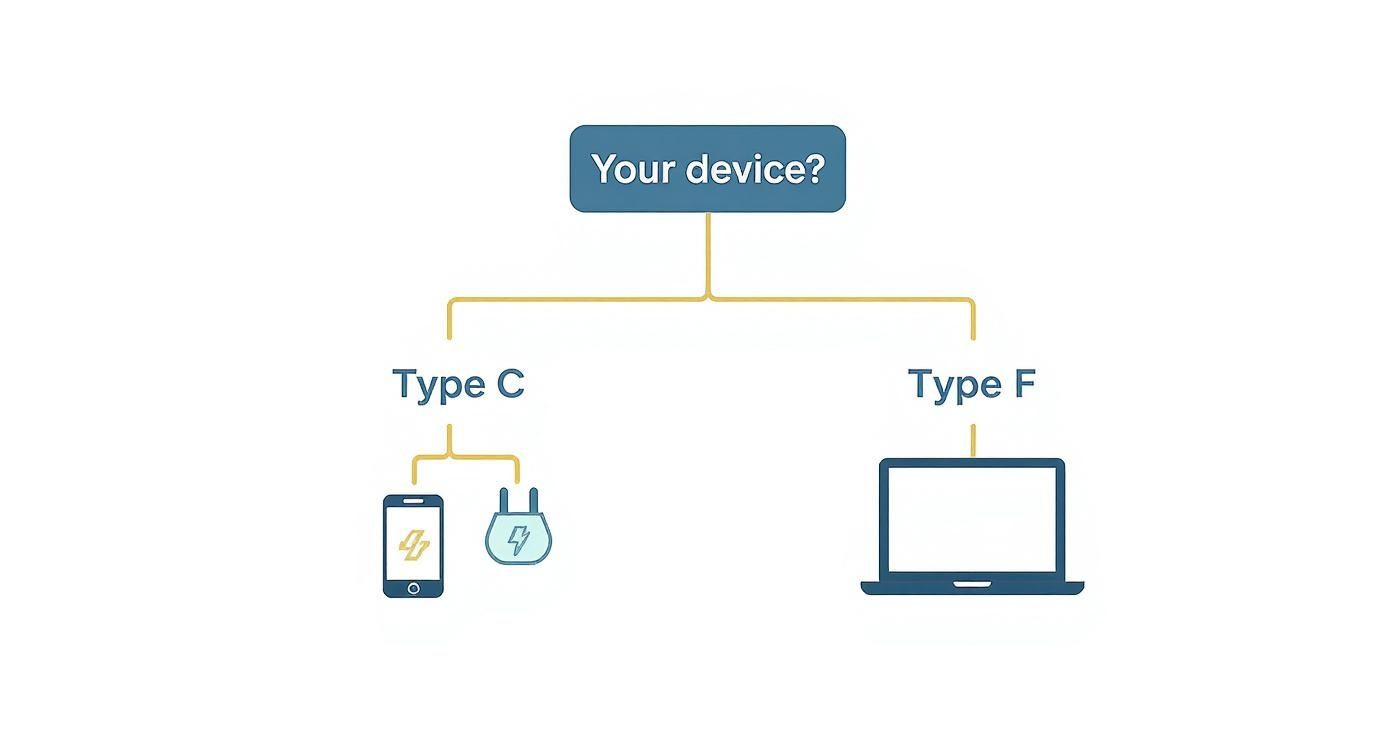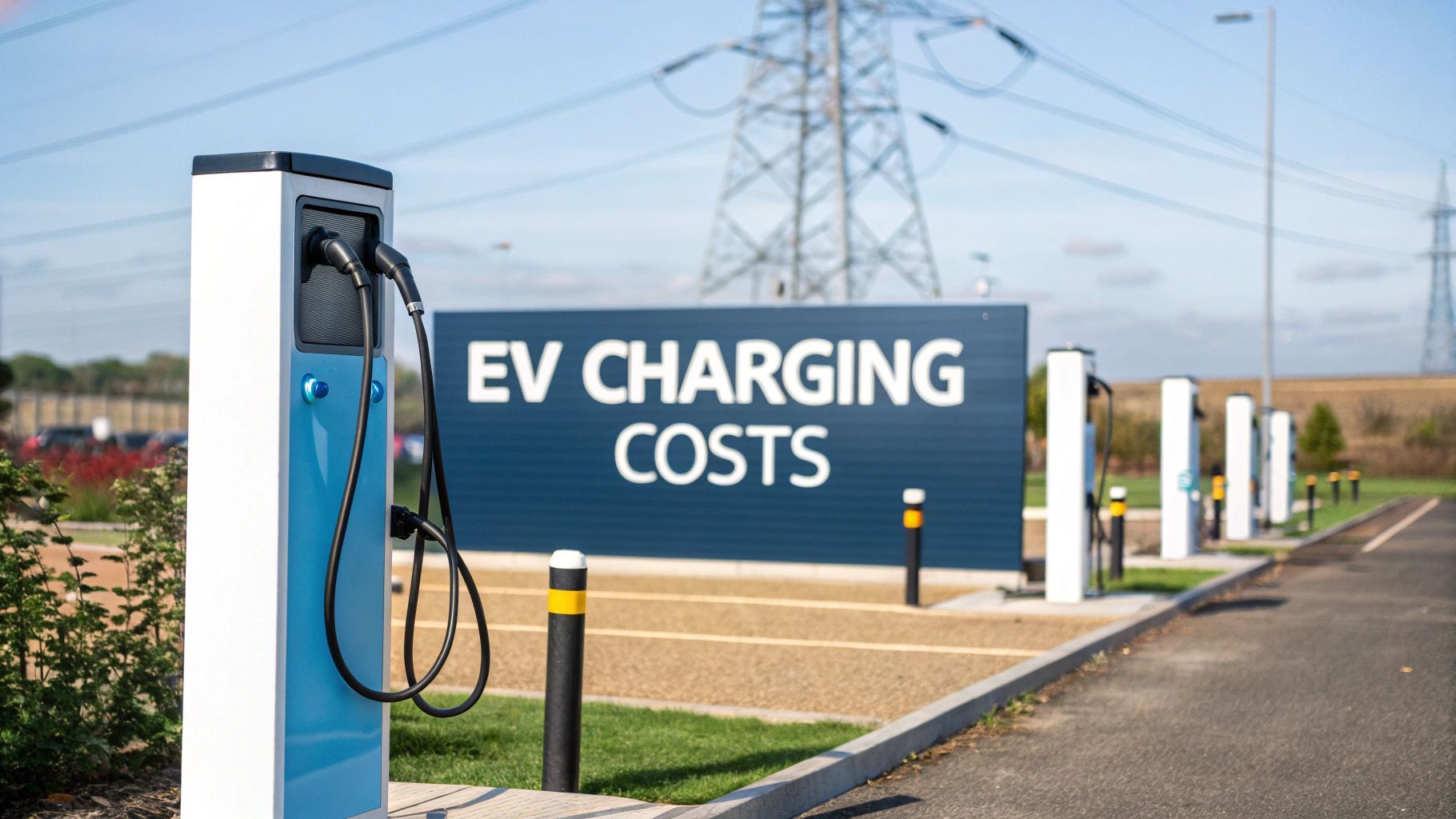Your Guide to the Right Spain Converter Plug
Heading straight to Spain with your UK gadgets? Hold on a moment. The short answer is no, your UK plugs won't fit directly into a Spanish wall socket. It’s a classic travel snag many people hit – the UK’s chunky three-pronged Type G plug is a completely different beast to Spain’s two-pronged Type F sockets.
To get your devices powered up, you'll need a simple spain converter plug , which is really just a travel adapter. This is particularly crucial if you are planning to use mobile EV charging solutions for your electric vehicle, as ensuring a correct and safe connection is paramount.
Understanding Why UK Plugs Need an Adapter in Spain

Planning a Spanish getaway is half the fun but getting the practical bits right is what makes for a truly smooth trip. One of the most common oversights for UK travellers is assuming their chargers will just plug straight in. It's an easy mistake to make but it’s a bit like trying to fit a square peg in a round hole; the shapes just don't match up.
The problem is purely physical. The UK uses the very distinct Type G plug, with its three large, rectangular prongs. Spain, along with most of its European neighbours, uses the Type F socket (often called a 'Schuko' socket), which is designed for plugs with two round pins. This standardisation is helpful but differs from the UK system.
To give you a clearer picture, here's a quick breakdown of the differences.
UK vs Spain Electrical Systems at a Glance
| Feature | United Kingdom (UK) | Spain |
|---|---|---|
| Plug Type | Type G | Type C / F |
| Socket Type | Type G | Type F |
| Prongs | 3 Rectangular Prongs | 2 Round Pins |
| Voltage | 230 V | 230 V |
| Frequency | 50 Hz | 50 Hz |
As you can see, while the plug and socket shapes are a total mismatch, the crucial electrical specs are identical.
The Good News About Voltage
Luckily, the physical difference is pretty much the only hurdle you'll face. Both the UK and Spain run on a nearly identical electrical standard. Spain uses a standard voltage of 230 V with a frequency of 50 Hz , which is exactly what the UK uses. This means your modern electronics are already electrically compatible.
Because the voltage is the same, almost all modern gadgets from the UK—like your smartphone, laptop and camera chargers—don't need a heavy, complicated voltage converter. All you need is a straightforward travel adapter to bridge the physical gap between your UK plug and the Spanish socket.
This simplifies things enormously. You can forget about packing bulky and expensive converters. Instead, just toss a small, lightweight spain converter plug into your bag. This simple device allows your three-pronged UK plug to fit snugly into the two-pin sockets you'll find all over Spain, keeping your devices charged and ready for your adventures. This is also relevant for low-power mobile EV charging units that can operate from a standard domestic supply.
Getting to Know Spanish Sockets
Walk into your hotel room in Spain and the last thing you want is that sinking feeling when you realise your charger won't fit the wall socket. Luckily, figuring out Spanish plugs is refreshingly simple.
You'll quickly notice that Spain, along with most of mainland Europe, uses a standard socket known as 'Schuko' or Type F . It’s a recessed circular outlet with two round pinholes. You will find them everywhere, from slick city apartments in Barcelona to rustic villas in the Andalusian countryside.
The Anatomy of the Schuko Socket
So, what makes a Type F socket tick? Beyond its two main pinholes, its real genius lies in the grounding system. Unlike the three-pronged Type G plug we use in the UK, the Schuko design has two small metal clips at the top and bottom of the recess.
These spring-loaded clips are crucial. They make contact with grounding strips on the side of a compatible plug, creating a safe connection for any of your appliances that need to be earthed. This is essential for equipment like EV charging systems, where a reliable earth connection is a primary safety feature.
Here's a closer look at a standard Schuko plug and its socket.
You can see exactly how the plug’s pins line up with the holes, while the metal clips on the socket are perfectly positioned to connect with the plug. It's a robust design, widely adopted for good reason—it’s safe and secure.
A Note on the Versatile Type C Plug
While the sockets are nearly always Type F, you'll also come across a much slimmer, two-pin plug. This is the Type C , often called the 'Europlug'.
This simple little plug doesn't have a grounding connection, so it's only used for smaller, double-insulated electronics. Think phone chargers, electric toothbrushes and camera battery chargers—things that don't need that extra safety earth.
The great news for travellers is that the two-pin Type C plug fits perfectly into the more robust Type F socket. It just slots straight into the two main pinholes, making it an incredibly versatile plug for powering low-wattage gadgets across the continent.
So, when you buy a spain converter plug , it will be designed to fit snugly into these Type F sockets. Whether your UK device needs grounding or not, a good adapter will ensure the right connection is made. This standardisation across Spain and much of Europe makes powering your essentials a breeze once you have the correct adapter in your bag.
Finding the Best Spain Converter Plug for Your Trip
Choosing the right travel plug before you jet off can feel like one more thing on a never-ending to-do list but it's actually much simpler than you think. The key is getting your head around one crucial difference: the distinction between a travel 'adapter' and a voltage 'converter'. For a trip to Spain, knowing this is everything.
Think of a travel adapter as a simple translator. It doesn't change what's being said, just the language it's spoken in. In this case, it changes the shape of your UK plug so it can physically slot into a Spanish socket. A converter, on the other hand, is a much bigger deal—it’s like a power transformer, stepping the electrical voltage up or down.
The good news? For nearly all your modern gadgets—phones, laptops, camera chargers—a basic adapter is all you’ll need. This is because most are built to be dual-voltage, meaning they can handle different electrical currents automatically. Since both the UK and Spain run on a very similar 230V standard, the only barrier is the plug's physical shape. That makes a simple Spain converter plug (which is really just an adapter) the perfect, hassle-free solution.
What to Look for in a Reliable Adapter
When you're picking an adapter, this isn't the time to cut corners. A cheap, poorly made plug isn't just an inconvenience; it can be a genuine safety hazard, especially when dealing with high-load applications like rapid EV charging from constrained grid connections.
Here's what to keep an eye out for:
- CE Safety Markings: First things first, look for the 'CE' mark. This little logo is your assurance that the product meets the European Union's strict safety, health and environmental standards. Don't buy an adapter without it.
- Sturdy Build Quality: Give it a squeeze. Does it feel solid or flimsy? A well-built adapter won't feel hollow or cheap. The pins should be firm, not wobbly, ensuring a secure connection that won't leave your plug hanging precariously out of the wall.
- Grounded vs Ungrounded: Take a look at your UK plug. If it has three prongs, it's grounded, which is an important safety feature. To maintain that protection, you'll need a grounded adapter that can connect with the grounding clips found on Spain's Type F sockets.
While most of continental Europe settled on the Type C or F plug, the UK has always gone its own way with the chunky, three-pronged Type G plug. Standardised back in 1947 under British Standards (BS 1363), it was designed with safety as its top priority. This historical split is why UK travellers have needed adapters for decades. In fact, it's estimated that a staggering 5 million plug adapters are sold to UK residents travelling to Spain, France and Germany every single year.
The decision tree below makes it even clearer, showing you which plug type you'll likely encounter based on the device you're using.

As the graphic shows, smaller devices often use the two-pin Type C, while larger ones need the grounded Type F. Luckily, Spanish sockets are designed to accept both, so you’re covered either way.
Before we move on, let's quickly summarise when you'd need an adapter versus a converter.
Adapter vs Converter: Which Do You Need?
| Device Type | Adapter or Converter? | Reasoning |
|---|---|---|
| Modern Electronics (Laptops, phone chargers, camera batteries) | Adapter Only | These are almost always "dual voltage" (100-240V) and adjust automatically. They just need to fit the socket. |
| Simple Heating Appliances (Hair straighteners, travel kettles) | Check the Label! | If it's dual voltage, an adapter is fine. If it's single voltage (UK only), you'll need a converter. |
| High-Power, Single-Voltage Devices (Older hairdryers, kitchen appliances) | Converter | These items are not designed for Spain's voltage and could be damaged without a converter to step down the power. |
| Most UK items | Adapter Only | Because the UK and Spain both use ~230V, a converter is rarely needed for voltage. The issue is the plug shape. |
Essentially, for 99% of what a typical tourist packs, a simple, good-quality adapter is all you need for Spain.
The Universal Adapter Option
For the serious globe-trotter, a universal adapter can be a fantastic bit of kit. These clever all-in-one gadgets have a series of sliding pins and levers, allowing you to configure the plug to fit sockets in hundreds of different countries.
The main draw is pure convenience—one device to rule them all. No more rummaging through a bag of different adapters. The trade-off? They're often bulkier and pricier than a dedicated Spain adapter. And while they cover most major regions, it's always smart to be aware of local quirks; for example, you can see how standards differ quite a bit in our guide on electric plugs in Chile for EV charging.
Staying Safe While Using Your Electronics Abroad
Getting your gadgets charged up on holiday shouldn't come at the cost of safety. Using your Spain converter plug correctly is simple enough but skipping a few basic checks can lead to fried devices or, even worse, a serious electrical hazard. A little bit of caution goes a long way in making sure you can power up without a worry.

First things first, always make sure your adapter sits snugly in the Spanish socket. If it's loose and wobbly, you've got a problem. A poor connection can cause sparks, creating a major fire risk that can easily damage both the adapter and your charger. Give it a gentle wiggle before plugging anything in to be certain it’s secure.
You also need to be mindful of what you're plugging in. Wall sockets are only designed to handle a certain electrical load. Don't try to overload a single outlet by plugging a power-hungry hairdryer into an extension lead that's already charging your laptop, tablet and phone all at once. This principle is vital in large-scale applications, where managing distributed energy resources is key to preventing grid overload.
Avoid Common Electrical Dangers
One of the biggest mistakes travellers make is buying cheap, uncertified adapters on a whim. Trying to save a few quid on a flimsy, unbranded model is a classic false economy. It’s like opting for a dodgy life jacket to save money – the risk just isn’t worth it. Always look for adapters with the CE (Conformité Européenne) mark, which confirms they meet EU safety standards.
Another golden rule: never "daisy-chain" adapters. Plugging one travel adapter into another to try and reach a faraway socket is a recipe for disaster. This creates an unstable connection that can overheat in no time.
An overheating plug or adapter is a massive red flag. If you notice a strange plastic smell, see any discolouration, or find that the plug is hot to the touch, unplug it immediately. Don’t use it again.
Finally, a few bits of simple common sense will keep you safe for your whole trip.
- Check for Damage: Before you use it, give your adapter a quick once-over. Look for any cracks, bent pins, or other signs of wear and tear.
- Keep Away from Water: This one should be obvious, but never charge your devices near water, like in the hotel bathroom. The risk of electric shock is very real.
- Unplug When Not in Use: Once your device is charged or you're heading out of your room, it's always good practice to unplug the adapter from the wall. It minimises any potential risks and gives you peace of mind.
Where to Find a Reliable Travel Adapter
When it comes to getting your hands on a Spain converter plug , you’re faced with a pretty straightforward choice: buy one before you leave the UK, or pick one up after you’ve landed in Spain. Both routes work but a bit of forward thinking can save you a fair bit of hassle and cash.
For anyone who likes to be organised, buying your adapter in the UK is the smart move. It means you can get your phone charging the moment you drop your bags, without the frantic search for a shop while your battery icon flashes red. It also gives you the time to do your homework and pick a quality, certified product.
Buying Your Adapter in the UK
Honestly, sorting out your travel plug before you fly is almost always the best option. You'll find a much bigger selection and can easily check for important safety certifications, like the CE mark , which is a must-have.
Here’s where to look in the UK:
- High-Street Electronic Shops: Places like Currys or Robert Dyas are a great shout. The staff can give you proper advice and you can get a feel for the adapter's build quality before you part with your money.
- Major Supermarkets: The big players like Tesco or Asda usually have a travel aisle where you can find decent, no-frills adapters at a sensible price.
- Trusted Online Marketplaces: Websites like Amazon are brilliant for variety but you have to be careful. Stick to well-known brands like Ceptics or Epicka and always, always read recent customer reviews and look at their photos. It’s the best way to dodge fakes or flimsy rubbish that could be a fire hazard.
- Airport Shops: They’re handy if you’ve had a last-minute brain-fade but be warned. Airport shops know you're a captive audience and the prices reflect that. Expect to pay a lot more than you would on the high street.
Buying in advance isn't just about getting a safe, certified adapter – it's about avoiding the "tourist tax". Arriving in Spain ready to go means you can focus on the important stuff, like finding the nearest tapas bar, not hunting for a charger.
Finding an Adapter in Spain
Right, so you’ve landed in Spain and realised you forgot an adapter. Don’t panic. You can definitely find one but you need to know where to look to avoid getting ripped off.
Your best bet is to find a 'ferretería' , which is just the Spanish word for a hardware store. These are proper local shops selling quality electrical gear at local prices. Big supermarkets like Carrefour or Mercadona are also solid choices and often sell multi-packs which can be great value.
What you really want to avoid are the small tourist or souvenir shops, especially in the heart of the big resorts. They’ll almost certainly have adapters but they’re usually cheap, uncertified tat sold at a ridiculous markup. Steer clear.
Common Adapter Mistakes and How to Avoid Them
A great holiday often hangs on getting the little things right and sidestepping those small, frustrating problems that can completely throw a spanner in the works. When it comes to using a Spain converter plug , a few common mistakes trip up travellers time and again but they’re all easy enough to avoid with a bit of forward thinking.
The most frequent blunder is simply forgetting to pack one in the first place. We've all been there: that sinking feeling when you arrive at your hotel with a dead phone, only to realise your adapter is sitting uselessly on the kitchen counter back home. This usually leads to a frantic late-night search and paying way over the odds at a tourist trap.
Simple Habits for a Smooth Trip
Another classic error is grabbing the cheapest, flimsiest adapter you can find online. These poorly made gadgets often break after a single use, leaving you powerless. Worse still, they can be a genuine safety hazard. Investing just a few extra pounds in a sturdy, certified adapter is one of the smartest travel decisions you can make.
Finally, there’s the all-too-common mistake of leaving your only adapter behind, plugged snugly into the hotel wall socket. It’s an easy oversight when you’re rushing to check out and catch a flight.
To dodge these common pitfalls, just adopt a simple mantra before you travel: Pack it, check it and don't forget it. Make your travel adapter a permanent resident of your travel bag or carry-on, so it’s always ready to go when you are.
Here are a few practical tips to make sure you never get caught out:
- Buy a Spare: For the small cost, having a backup adapter tucked away in your luggage provides fantastic peace of mind. If one breaks or gets left behind, you're still covered.
- Set a Reminder: When you’re packing up to leave your hotel, set a quick reminder on your phone to specifically check the wall sockets for your adapter and chargers.
- Choose a Bright Colour: A brightly coloured adapter is much harder to miss against a plain white wall than a standard black or white one. It's a simple visual cue that can save you a lot of hassle.
Building these simple habits ensures your devices stay powered up, letting you focus on what really matters: enjoying your trip. While Spain's plug system is pretty straightforward, other destinations have their own unique standards; you can learn more by reading our guide on electrical plugs used in Greece.
Frequently Asked Questions
Still got a few questions buzzing around about power adapters for your trip? No worries. We've put together some quick answers to the most common queries we hear from UK travellers heading to Spain.
What Is the Main Difference Between a UK and a Spanish Plug?
The main difference is just the shape. UK plugs, known as Type G, are the chunky ones with three rectangular prongs. Spanish plugs, on the other hand (Type C or F), use two simple round pins.
The good news? The actual electricity flowing through the wires is virtually identical at 230V / 50Hz . For most modern gadgets, this means you won’t need a voltage converter at all.
Is It Better to Buy an Adapter in the UK or Spain?
It’s almost always a better bet to buy your adapter here in the UK before you set off. You’ll find a much wider choice of certified, safe products and can easily sidestep the inflated prices you often find in tourist traps abroad.
Buying in advance just means you’re ready to plug in and charge up the moment you check in. Simple.
For travellers with multiple devices, a universal adapter with several USB ports can be a great investment. These often combine multiple plug types into one unit, making them useful for future trips beyond Spain. This is especially useful for managing EV charging and batteries for other portable devices simultaneously.
Do I Need a Converter or Just an Adapter for Spain?
For the vast majority of UK travellers, you only need a simple plug adapter. That's because modern electronics like phones, laptops and camera chargers are built to be dual-voltage, meaning they can handle different electrical currents automatically.
You’d only need a bulky voltage converter for much older, single-voltage items. Think things with heating elements or motors that were never designed for travel in the first place.
What Should I Look for When Buying a Travel Adapter?
Safety and build quality should be your top priorities. Always look for an adapter that has the CE mark , which confirms it meets European safety standards.
It should feel solid in your hand, not flimsy and fit snugly into the socket without any wobbling. If your UK device has a three-pin plug, make sure you get a grounded adapter to keep that extra layer of safety intact.
For more technical questions about electrical systems and charging infrastructure, feel free to check out our own list of frequently asked questions about energy solutions.
Planning your holiday should be exciting, not a headache over plugs and sockets. Making sure you have a reliable adapter means all your devices will be ready for your Spanish adventure.
For businesses looking at larger-scale energy solutions, from EV charging from constrained grid connections to integrating on-site renewables with grid-scale batteries, ZPN Energy offers robust, UK-developed systems to meet your needs. Explore our advanced energy technologies at https://www.zpnenergy.com.








